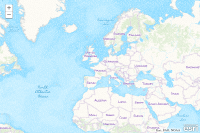 Hide Table of Contents
Hide Table of Contents
 Analysis
Analysis
 Dynamic Layers
Dynamic Layers
 Editing
Editing
 Feature Layers
Feature Layers
 Feature Table
Feature Table
 Graphics
Graphics
 Map
Map
 Mobile
Mobile
 Online and Portal
Online and Portal
 Popups and Info Windows
Popups and Info Windows
 Query and Select
Query and Select
 Renderers, Symbols, Visualization
Renderers, Symbols, Visualization
 Search
Search

Vector tiles
Explore in the sandbox
Open in CodePen
View live sample
Description
This sample shows how to add a VectorTileLayer to a map. A VectorTileLayer displays cached data in vector format, making the styles of its layers customizable on the client.
Unlike image caches, vector tiles contain data for rendering the tile information. Because the data in VectorTileLayer is vector, it is stored in individual layers containing geometry, attributes, and styles that may be customized by the developer client-side.
Code
<!DOCTYPE html>
<html>
<head>
<meta http-equiv="Content-Type" content="text/html; charset=utf-8">
<meta name="viewport" content="initial-scale=1, maximum-scale=1,user-scalable=no"/>
<title>VectorTileLayer sample</title>
<link rel="stylesheet" href="https://js.arcgis.com/3.46/esri/css/esri.css">
<style>
html,
body,
#map {
height: 100%;
width: 100%;
margin: 0;
padding: 0;
}
</style>
<script src="https://js.arcgis.com/3.46/"></script>
<script>
require([
"esri/map",
"esri/layers/VectorTileLayer",
"dojo/domReady!"
], function(Map, VectorTileLayer) {
var map = new Map("map", {
center: [2.3508, 48.8567], // longitude, latitude
zoom: 2
});
//The URL referenced in the constructor may point to a style url JSON (as in this sample)
//or directly to a vector tile service
var vtlayer = new VectorTileLayer("https://www.arcgis.com/sharing/rest/content/items/4cf7e1fb9f254dcda9c8fbadb15cf0f8/resources/styles/root.json");
map.addLayer(vtlayer);
});
</script>
</head>
<body>
<div id="map"></div>
</body>
</html>